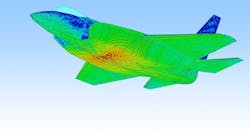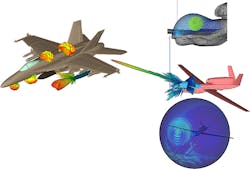Simulate Installed Antenna and RF Co-Site Issues with EM Tools
Download this article in PDF format.
Modern aircraft contain many sophisticated electronic systems for communications, telemetry, navigation, guidance, radar detection, tracking, and more. Onboard radar systems typically help to maintain safety along the flight path by detecting thunderstorms, identifying regions of potential turbulences, and avoiding collisions. Other antenna-enabled systems for command and control, such as Identification Friend or Foe (IFF), also exist on commercial and military aircraft. In all of these avionic systems, antennas are key internal components. Their performance is critical to ensure these systems function properly.
For a long time, aircraft antenna designers have grappled with the challenges associated with designing antennas, integrating antennas into airborne avionic systems, and determining the best locations to install these systems on an aircraft. The build-and-test approach can address some of these challenges. However, for a vehicle as complex, large, and advanced as an aircraft, organizations are bound to incur huge expenses when they follow this approach.
To understand the difficulty involved, this method requires test chambers (which are sometimes very large), scheduling vehicle assets and their equipment, and significant manpower, as well as considerations in terms of infrastructure and facilities. Each of these requirements can be prohibitively expensive, potentially limiting the scope of testing available within a given project.
The Modeling and Simulation Solution
In contrast, modeling and simulation offers an economical, smart, and efficient means of rapidly addressing these design and engineering challenges (Fig. 1). The end result is usually improved system performance and compressed design cycles.
1. Currently available modeling and simulation tools can address the challenges associated with aircraft antenna systems.
Many electromagnetic (EM) simulators are available for designing antennas. Key factors that influence the choice of EM simulation tool include accuracy, speed, usability, and efficiency.
With ANSYS EM tools, one only needs to import the design’s geometry and specify materials and the excitations. ANSYS HFSS automatically generates accurate solutions for EM problems, thereby alleviating the user from knowing how the device works in order to know how to mesh the design. Moreover, ANSYS EM tools are equipped with many solver technologies.
Furthermore, HFSS SBR+ and ANSYS EMIT can be used in conjunction with HFSS. Users can then follow a smooth and integrated workflow for simulating installed antenna and RF system performance on airborne platforms. In addition, it’s possible to achieve RF co-site interference between RF systems.
Simulation Workflow
A simulation workflow can be followed to solve diverse sets of EM problems concerning antenna integration on an aircraft. This workflow involves only a few steps from initiation to completion. Generally, an antenna is initially designed under the assumption that it exists in free space by itself or on a ground plane. In the first step, one can select a standalone antenna element from a known set of antenna topologies already available in an antenna design toolkit. These antennas are preconfigured—users only need to enter the desired frequency. HFSS then automatically creates the antenna.
Additionally, users have the flexibility to modify antenna properties, such as dimensions and materials. Any antenna from the toolkit comes in a ready-to-solve state. Reports are automatically generated for return loss, 2D and 3D radiation patterns for antenna gain, and animations of electric fields, etc. Since antennas couple to their local environment, the next step of the workflow involves adding the antenna to its housing. A simulation can then be run to understand the antenna’s performance within the system.
Next, the user can create an HFSS 3D component of this final model to facilitate sharing the design with vendors, customers, and collaborators. A noteworthy feature of the HFSS antenna toolkit is its ability to generate parameterized antennas. This capability allows users to vary antenna sizes and other properties as needed to fit them within their respective systems. Moreover, a parameterized design makes it much easier to tune the antenna.
HFSS offers several features like optimization, automated parametrics, tuning, and analytic derivatives that aid with antenna tuning and integration. With these features, one can generate a 3D component model (of the antenna in its system) to eventually add to a large assembly, i.e., the aircraft. Furthermore, 3D components facilitate the creation of wireless communication systems by enabling easy drag-and-drop assembly of complex systems from a set of predefined components.
An HFSS 3D component is extremely useful, especially as these avionic systems become increasingly complex and users need to leverage pieces of a system’s design from other sources. Think of an HFSS 3D component as a self-contained model comprising the antenna feed-point and EM characteristics wrapped up in a plug-and-play module. It is immediately ready for use once connected to a large assembly, such as an aircraft.
HFSS 3D components can be encrypted and password-protected. Users are able to hide internal details of the structure, materials, and other properties that comprise the antenna design. Antenna vendors can use these features to protect their intellectual property and easily share the 3D components with system integrators, while allowing the same system integrators to simulate, design, and integrate with the deep rigorous simulation approach of HFSS. Since 3D components are simulation-ready, users can execute the next workflow step of performing installed antenna analysis with minimal additional user input.
Solutions for Problems of All Sizes
ANSYS HFSS has many solvers suited for different kinds of EM problems. Finite element solvers in HFSS can be used to simulate and design the antenna elements in detail. Users can then extend the simulation scale and perform installed antenna analysis with the integrated 3D method-of-moments (MoM) solver that now comes with HFSS (as of ANSYS 18).
2. Software tools allow for EM analysis of very large platforms, such as aircraft.
HFSS SBR+ can be employed for very electrically large problems. It uses a high-frequency asymptotic shooting and bouncing ray technique to track the scattering of EM energy across hundreds or even thousands of wavelengths (Fig. 2). Full-wave results from HFSS can be employed as initial excitations for SBR+ when solving scattering problems in electrically large structures.
For instance, an antenna or array integrated into an aircraft body is sensitive to the shape of the aircraft. The antenna’s radiation pattern is affected by the surface currents on the aircraft. The pattern also experiences blockage by wings and engines, as well as multi-path reflections between structures like stabilizers and wings. Analysis in HFSS and HFSS SBR+ provides critical insights into an antenna’s behavior when integrated on its platform. HFSS and HFSS SBR+ can also be used to model antenna-radome interactions to assess the antenna’s complete installed performance.
Finally, it’s important to consider antenna-to-antenna coupling issues when designing antenna systems. Since there are multiple antennas on an aircraft, the coupling—including out of band—can lead to interference between the associated radios and RF systems.
In the final step of the workflow, ANSYS EMIT can be used to predict and mitigate these interference issues, known as co-site RFI. ANSYS EMIT, with its built-in radio and component models, can solve the full aircraft system and predict the performance of the entire wireless system on the aircraft. Easy to use and interpret “RF threat matrices” can help an engineer determine and test mitigation strategies with the system simulations available in EMIT.
In the end, the combination of HFSS, HFSS SBR+, and EMIT help engineers devise a system frequency plan for ensuring smooth and interference-free operation of wireless systems. By following this integrated simulation workflow, ANSYS EM tools can predict the performance and improve the reliability of wireless systems on an aircraft. This approach helps reduce design cycles, and in turn saves on costly empirical testing and shrinks development time.
For more information about the workflow, visit ansys.com.
About the Author
Shawn Carpenter
Program Director – Electronics Product Management, Ansys
Shawn Carpenter received his BEE degree in electrical engineering from the University of Minnesota Institute of Technology in 1988, and an MSEE in Electrical Engineering from Syracuse University in 1991 concurrently with the General Electric Thomas Edison Advanced Course in Engineering program. He has served as a Senior Microwave Engineer in Module Design and Array Technology for the GE Aerospace Electronics Laboratory (Syracuse, NY), VP Sales and Marketing for Sonnet Software Inc., and Director, Sales & Marketing for Delcross Technologies.
Shawn joined Ansys Inc. during the 2015 acquisition of Delcross Technologies and is currently a Program Director for 5G and Space applications. His current interests include phased-array modeling techniques for MIMO and adaptive beamforming, installed antenna-host interactions, mmWave radar sensor modeling, and wireless physical channel modeling for electrically large environments. He’s also an active amateur radio (ham) operator with the callsign N2JET, embracing a hobby he adopted at age 11.
Matthew Commens
Matthew Commens is a Ph.D.



